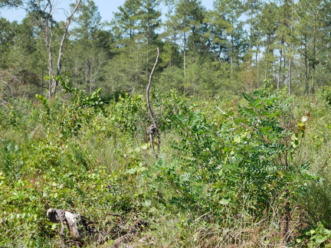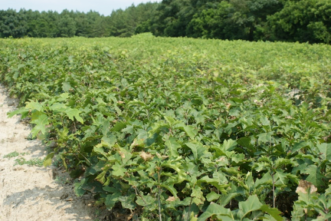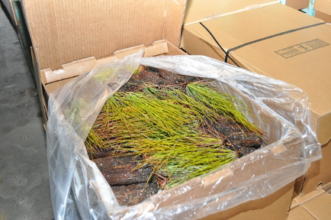The selection of tree seedlings for reforestation or the conversion of open land to woodlands may only occur a few times over the ownership of a property. Therefore, making sure that the right seedlings are purchased is a significant step in woodland management. When selecting seedlings, the factors to consider are landowner objectives, soils and other site characteristics, seedling sources and availability, and seedling cost.
Landowner Objectives
Landowner objectives should be the foundation for any management decisions made on a forested property. When selecting tree seedlings to purchase and plant, site characteristics may limit species options. Still, landowners usually have some choices they can make among species to meet their management objectives. Management objectives can include producing timber income, enhancing wildlife habitat, reintroducing native species, improving aesthetics, stabilizing soils due to water or wind erosion, increasing stocking of desired species within an existing stand, or providing an additional source of income such as pine straw production.1
Often, the selection of a single species can meet multiple management objectives. For example, the recent emphasis on the reestablishment of longleaf pine within its natural range has led to an increased interest in planting longleaf seedlings. Longleaf is a pine species that can provide income from timber and pine straw production, is aesthetically unique, and can also enhance wildlife habitat when managed with prescribed fire. Hardwood seedling selection can also meet multiple objectives. Planting oaks can establish a future income source from timber, improve aesthetics on a property, and provide additional sources of mast for a wide variety of wildlife species.
Soils and Other Site Characteristics
One of the most critical factors influencing seedling selection is the planting site characteristics. These include soil types and potential productivity, past management history, hydrology, flooding or drought potential, slope and slope aspect, and impacts from existing vegetation or nuisance wildlife. Identifying native tree species that thrive on adjoining acreage is often a good starting point when considering which seedlings to plant. Pine species can generally grow on a range of acidic (pH ≤ 6.5) to neutral (pH of 7) soils; hardwoods are adapted to a broader range of soil characteristics.2 Selecting a species adapted to the pH of the soil where seedlings will be planted is a better option than trying to amend soils to adjust the pH.
Landowners who are not familiar with the soils on their property can use the Web Soil Survey, an online mapping application hosted by the USDA Natural Resources Conservation Service. The Web Soil Survey gives information on soil series, site index, soil properties, soil suitability for management practices (e.g., site preparation and planting), and even the risk of seedling mortality based on soil characteristics. The soil properties listed on the Web Soil Survey include flooding and erosion hazard, drought potential, and other soil characteristics that could affect seedling suitability. Sites that have been in agricultural use may also need to have a soil sample taken and analyzed to see if there are residual effects from past practices that could impact seedling establishment. Residual effects could include high levels of residual fertilizers and agricultural chemicals or improper pH.3
Also, evaluate existing vegetation in the area to be planted before selecting and ordering seedlings. To ensure seedling success, adequate site preparation should be planned before planting any area, whether it is a recent clearcut, an old field, or a pasture.3 For additional information about the site preparation process refer to Adequate Site Preparation Can Enhance Productivity of New Forest Stands. Competition from grasses, herbaceous vegetation, or natural hardwood and pine regeneration can drastically reduce planted seedling survival rate, requiring replanting at an additional expense. Successful site preparation and early rotation competition control are also crucial when planting more expensive varieties of pine seedlings since competition can reduce the additional growth potential from better genetic stock.4,5 Figure 1 is an example of a six-month-old clear-cut that has not been site prepared and contains vegetation that would outcompete planted seedlings if not adequately treated.

Figure 1. This six-month-old clear-cut contains a variety of vegetation that could outcompete planted seedlings. Image credit: Janet Steele, Clemson Extension.
Finally, impacts from wildlife can reduce seedling survival success. Feral hogs and white-tailed deer are usually the most destructive to newly planted pine and hardwood stands. Feral hogs can destroy containerized longleaf seedlings by rooting and consumption, as longleaf seedlings are a favored food. Complete planting failures may occur if seedlings are not protected in areas with a large population of feral hogs. White-tailed deer will browse hardwood seedlings and also buds on pine seedlings. Typically, exclusion devices (e.g., fencing or tree shelters) can be costly on larger reforestation areas and are most often used on higher-value hardwood plantings.6 Exclusion devices also require regular maintenance to successfully restrict wildlife access to a reforestation area or reduce negative impacts on the planted seedlings, such as restriction of growth by installed tree shelters.
Seedling Sources and Availability

Figure 2. Oak seedlings growing in beds at Taylor Nursery, Trenton, SC are an example of local root stock available to landowners. Image credit: SC Forestry Commission.
Purchasing either pine or hardwood seedlings from genetic stock adapted to typical site conditions at the planting site is one of the keys to a successful planting. Seedlings should be selected from seed sourced within a 150-mile radius of the planting location.4 South Carolina landowners are fortunate to have access to pine seedlings grown from genetically improved seed sourced from within the region and a wide variety of native hardwood species (figure 2).
Seedling availability can be a limiting factor when ordering species or varieties that are in high demand. As the demand for containerized pine seedlings has grown, most producers recommend pre-ordering as soon as a reforestation or afforestation plan is finalized for the coming planting season. Popular hardwood species, such as those planted for wildlife benefit, can also sell out quickly. See table 1 for commonly available tree species sold in South Carolina.
Table 1. Commonly available tree species sold in South Carolina and characteristics for suitability to sites within their native range.7,8
| Commonly Available
Native Species |
Ideal Site Characteristics | General Native Range in SC |
| Baldcypress
Taxodium distichum |
Very wet soils and tolerates standing water | Coastal Zone, Coastal Plain |
| Black Walnut
Juglans nigra |
Deep, well-drained bottomland soils; north & east slopes and in coves on upland sites | Coastal Zone, Coastal Plain, Piedmont & Blue Ridge |
| Chickasaw Plum
Prunus angustifolia |
Sandy soils but tolerates heavy clays and clay-loams | Statewide except eastern Coastal Zone and Coastal Plain |
| Dogwood
Cornus florida |
Range of soils except extremely dry or extremely wet | Statewide |
| Eastern Red Cedar
Juniperus virginiana |
Dry soils to moist, well-drained loamy soils | Western Coastal Plain, Piedmont, Blue Ridge |
| Eastern Redbud
Cercis canadensis |
Moist, well-drained sandy-loam and clay-loam soils | Statewide |
| Oak, Cherrybark
Quercus pagoda |
Loamy, well-drained bottomland soils but low tolerance for saturated soils or standing water | Southern Coastal Zone and Southern Coastal Plain; northern Pee Dee River basin |
| Oak, Live
Quercus virginiana |
Moist, well-drained sandy and clay soils; tolerant to occasional flooding and drought | Coastal Zone, Coastal Plain, and Sandhills |
| Oak, Red
Quercus rubra |
Well-drained sandy-loam and clay -loam soils on middle and lower north and east-facing slopes | Piedmont and Blue Ridge |
| Oak, Shumard
(Swamp Red Oak) Quercus shumardii |
Moist, well-drained loamy soils along streams and on river terraces; low tolerance for flooding | Coastal Plain |
| Oak, Swamp Chestnut
Quercus michauxii |
Well-drained, silty clay and loam soils | Coastal Zone and Coastal Plain |
| Oak, White
Quercus alba |
Deep, moist, well-drained soils but can tolerate droughty soils and occasional saturation | Statewide |
| Oak, Willow
Quercus phellos |
Moist, well-drained soils; in drier regions of state found in low areas along creek drains | Statewide except western Piedmont |
| Persimmon
Diospyros virginiana |
Moist, well-drained soils but can tolerate droughty, poor soils | Statewide |
| Pine, Loblolly
Pinus taeda |
Broad range of soils except in very wet or highly eroded shallow soils | Coastal Zone, Coastal Plain, Sandhills, Piedmont |
| Pine, Longleaf
Pinus palustris |
Broad range of soils except poor drained or saturated; productive on deep sands | Coastal Zone, Coastal Plain, Sandhills, Eastern Piedmont |
| Pine, Shortleaf
Pinus echinata |
Broad range of soils except those that are excessively drained | Statewide except northern Sandhills and northern Coastal Plain |
| Pine, Virginia
Pinus virginiana |
Well-drained clay and sandy loam soils; can tolerate poor, severely eroded sites | Piedmont & Blue Ridge |
| Pine, White
Pinus strobus |
Range of well-drained soils, from light sand to heavy clays | Blue Ridge |
| Southern Crabapple
Malas angustifolia |
Well-drained, moist soils; in drier regions of state found in low areas along creek drains | Southern Coastal Zone and Southern Coastal Plain; Sandhills |
| Sycamore
Platanus occidentalis |
Wide range of soils, including upland sites, but best growth on bottomland or riverine sites; can tolerate prolonged flooding | Statewide |
| Yellow Poplar
(Tulip Poplar or Tree) Liriodendron tulipifera |
Well-drained, deep, moist soils; intolerant of heavy, droughty, or wet soils | Southern Coastal Zone and Southern Coastal Plain; Sandhills, Piedmont, and Blue Ridge |
Cost
Cost is the final consideration when deciding what seedlings to order. Budgeted planting expenses should include both seedling acquisition and planting costs. The price per pine seedling varies significantly with the genetics of the seedlings ordered and whether they are bareroot or containerized (figure 3).
As forest industry-owned lands declined over the last decade, private companies acquired industry owned and operated seedling nurseries, along with decades of tree improvement research.5 Forest landowners can now purchase seedlings grown from genetic stock previously developed for planting on industry lands.4,5 Options in genetics for pine seedlings continue to increase, which means selecting from open-pollinated (least expensive), controlled mass pollinated, or clonal seedlings (most expensive) is a decision landowners now have to make when placing a seedling order.
Open-pollinated seedlings come from a known seed source that is fertilized by windblown pollen. The pollen source could be from within the orchard or be a contaminating source from outside the orchard, which can occur up to 50% of the time.9 Therefore, only half of the genetic stock of open-pollinated seedlings can be controlled. These are the most inexpensive seedlings to purchase. Controlled mass pollinated seedlings are produced from female cones that have been fertilized with specific pollen from a known genetic source. These seedlings can be two to four times as expensive as bareroot open-pollinated seedlings.4,5 Clones, which are identical replications of superior genetic stock, are the most expensive pine seedlings available and can be up to eight times more costly per thousand seedlings than bareroot open-pollinated seedlings.10
Landowners should research the potential productivity of the different varieties of seedlings that fit their reforestation budget and determine if the added expense of the superior genetics will provide them a greater economic return on their desired end product. The best genetics should only be considered when seedlings will be planted on sites with high productivity and where adequate site preparation and competition control will allow seedlings to reach their greatest potential growth rate and stem quality.4,5
The NC State University Tree Improvement Program has developed a rating system for loblolly pine genetic stock that has been progeny tested by their members. This system (PRS™) provides a rating for productivity, fusiform rust resistance, and stem straightness based on the progeny test stems at age six.11 Fusiform rust (Cronartium quercuum f. sp. Fusiforme) is a fungal infection of pines whose alternate host is oak species, particularly water oak (Quercus nigra). The research conducted by tree improvement programs has decreased the risk of fusiform rust in stands planted with pine seedlings grown from the most rust resistant families.12
A final decision for seedling selection is whether to order containerized or bareroot seedlings. One of the primary reasons containerized pine seedlings, particularly longleaf pine, are chosen is their increased survival rate over bareroot seedlings.10,13 Other benefits of containerized pine seedlings include extending the planting window and longer storage period. However, the cost of bareroot pine seedlings is about one-third to one-fourth of containerized seedlings; they can also be shipped and planted more cheaply. Therefore, bareroot seedlings are a good choice on moderate to high productivity sites and when planting will occur within the normal range of months (late November to mid-March). When planting hardwood seedlings, bareroot seedlings can be planted more easily than those that are potted, but potted seedlings tend to have better survival. Hardwood planting stock should also only be selected from within the geographic region where the seedlings are planted.4
Conclusion
Planning for the reforestation or afforestation should include careful consideration of landowner objectives, planting sites, and seedlings options. Selection of the most suitable species can provide multiple benefits and enhance a property for timber production, wildlife habitat, aesthetics, and soil and water protection. For assistance with seedling selection, information on seedling nurseries, and instructions on properly preparing a site and planting tree seedlings, contact your local Clemson Extension Forestry and Natural Resources Team Agent.
References Cited
- Fox T, Jokela E, Allen HL. The evolution of pine plantation silviculture in the Southern United States. Southern Forest Science: Past, Present, and Future. 2004 [accessed 2019 July 2]; 075:63–82. https://www.srs.fs.usda.gov/pubs/9647.
- Londo A, Kushla J, Carter R. Soil pH and tree species suitability in the south. Athens (GA): Southern Region Extension Forestry; 2006. [accessed 2020 August 21]. http://www.americaslongleaf.org/media/iqmc4tyw/soil-ph-tree-suitability-in-the-south-_sref_.pdf.
- Longleaf Note #7: Planting longleaf pine in old fields or pastures. Andalusia (AL): Longleaf Alliance; n.d. [accessed 2019 February 18]. https://longleafalliance.org/publications/LLNote7.pdf/view.
- Rousseau R. Choose your planting stock carefully. Starkville (MS): Mississippi State University Extension; 2015. [accessed 2020 July 13]. https://extension.msstate.edu/sites/default/files/publications/publications/p2589.pdf.
- McKeand S. The evolution of a seedling market for genetically improved loblolly pine in the southern United States. Journal of Forestry. 2019; 117(3): 293–301.
- McKenna J, Woeste K. Diagnosing and controlling wildlife damage in hardwood plantations. West Lafayette (IN): Purdue University Cooperative Extension Service; n.d. [accessed 2020 August 25]. https://www.extension.purdue.edu/extmedia/FNR/FNR-216.pdf.
- Radford A, Ahles H, Bell C. Manual of the vascular flora of the Carolinas. Chapel Hill (NC): The University of North Carolina Press; 1968.
- Plants Database. Greensboro (NC): USDA, Natural Resources Conservation Service (NRCS); 2020. [accessed 2020 July 13]. http://plants.usda.gov.
- Rousseau R, Roberts S, Herrin B. Comparison of second generation open-pollinated, mass control-pollinated, and varietal pine planting stock through 6 years on a North Mississippi site. Asheville (NC): U.S. Department of Agriculture, Forest Service, Southern Research Station; 2015. [accessed 2020 August 26]. https://www.srs.fs.usda.gov/pubs/gtr/gtr_srs203/gtr_srs203-020.pdf?.
- Barry J. Making sense of loblolly pine seedling varieties. Fayetteville (AR): University of Arkansas Cooperative Extension Service; 2011. [accessed 2020 July 13]. https://www.uaex.edu/publications/PDF/FSA-5030.pdf.
- Performance Rating System. Raleigh (NC):Tree Improvement Program, NC State University (n.d.); [accessed 2020 August 28]. https://www.treeimprovement.org/prs.
- Enebak P. Managing fusiform rust on loblolly and slash pine in forest and landscape settings. Auburn (AL): Alabama Cooperative Extension; 2019. [accessed 2020 October 28]. https://www.aces.edu/blog/topics/forestry/managing-fusiform-rust-on-loblolly-and-slash-pine-in-forest-and-landscape-settings/.
- Sung SS, Haywood JD, Leduc DJ, Sayer MS. (n.d.). Is planting stocktype critical to long-term field performance of longleaf pine? Asheville (NC): U.S. Department of Agriculture, Forest Service, Southern Research Station; 2020. [accessed 2020 October 10]. https://www.srs.fs.usda.gov/pubs/gtr/gtr_srs253/gtr_srs253_019.pdf.


